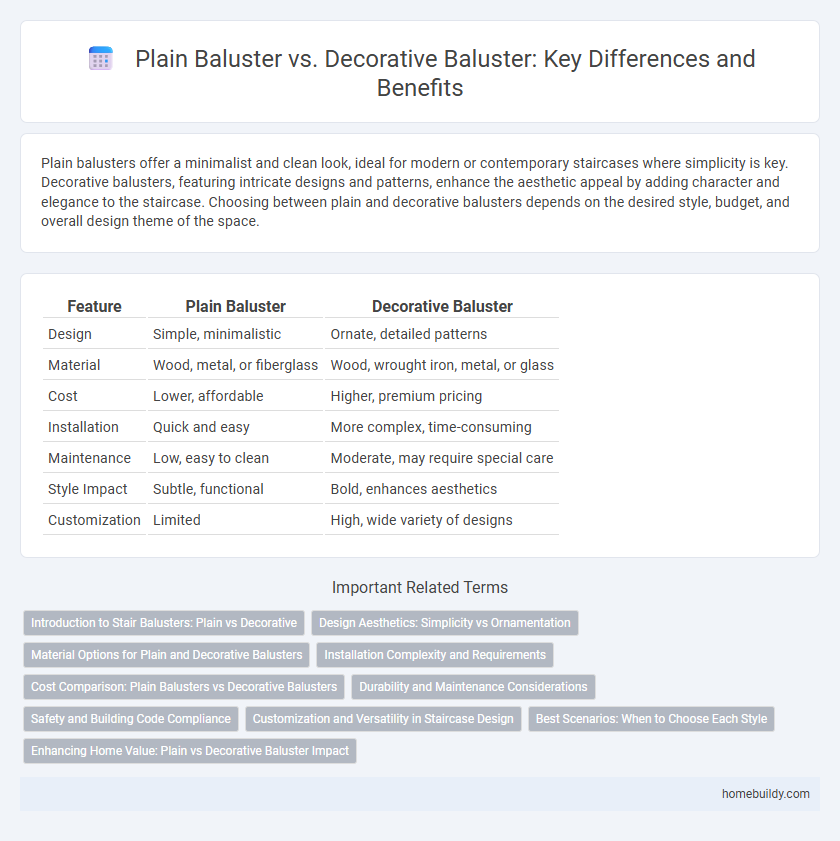Plain balusters offer a minimalist and clean look, ideal for modern or contemporary staircases where simplicity is key. Decorative balusters, featuring intricate designs and patterns, enhance the aesthetic appeal by adding character and elegance to the staircase. Choosing between plain and decorative balusters depends on the desired style, budget, and overall design theme of the space.
Table of Comparison
| Feature | Plain Baluster | Decorative Baluster |
|---|---|---|
| Design | Simple, minimalistic | Ornate, detailed patterns |
| Material | Wood, metal, or fiberglass | Wood, wrought iron, metal, or glass |
| Cost | Lower, affordable | Higher, premium pricing |
| Installation | Quick and easy | More complex, time-consuming |
| Maintenance | Low, easy to clean | Moderate, may require special care |
| Style Impact | Subtle, functional | Bold, enhances aesthetics |
| Customization | Limited | High, wide variety of designs |
Introduction to Stair Balusters: Plain vs Decorative
Plain stair balusters provide a clean, minimalist look ideal for modern and contemporary design styles, emphasizing functionality and simplicity. Decorative balusters feature intricate designs and detailed craftsmanship, often crafted from wrought iron, wood, or metal, adding elegance and character to staircases. Choosing between plain and decorative balusters depends on the aesthetic preference, architectural style, and desired visual impact of the stairway.
Design Aesthetics: Simplicity vs Ornamentation
Plain balusters offer a minimalist design aesthetic, emphasizing clean lines and simplicity that complement modern and contemporary staircases. Decorative balusters feature intricate patterns and ornamental details, enhancing traditional or classic stair designs with visual richness. Choosing between plain and decorative balusters significantly impacts the overall style, balance, and character of the stair railing system.
Material Options for Plain and Decorative Balusters
Plain balusters commonly utilize materials like wood, metal, and PVC, offering durability and straightforward aesthetics suitable for minimalist designs. Decorative balusters often incorporate wrought iron, glass, wrought brass, and finely carved wood, providing intricate patterns and enhanced visual appeal. Material choices influence the overall style, maintenance requirements, and cost, with decorative options typically demanding higher craftsmanship and customization.
Installation Complexity and Requirements
Plain balusters typically feature a straightforward design, which simplifies installation and reduces the need for specialized tools or skills. Decorative balusters often require precise measurements, custom fittings, and may necessitate professional installation due to their intricate shapes and added weight. Installation complexity increases with decorative balusters as alignment, securing techniques, and aesthetic consistency become critical factors.
Cost Comparison: Plain Balusters vs Decorative Balusters
Plain balusters typically cost between $5 and $15 per piece, making them a budget-friendly option for stair railing projects. Decorative balusters, however, can range from $20 to over $50 each due to intricate designs, materials like wrought iron or custom woodwork, and added craftsmanship. Choosing decorative balusters significantly increases overall project costs but enhances aesthetic appeal and architectural detail.
Durability and Maintenance Considerations
Plain balusters, typically made from materials like wood or metal with simple designs, offer higher durability due to fewer intricate details that can trap dirt or suffer damage. Decorative balusters, often crafted from wrought iron or ornate wood, require more frequent maintenance to preserve their aesthetic features and prevent corrosion or wear. Choosing plain balusters reduces upkeep time and cost, making them ideal for high-traffic areas where durability and ease of maintenance are priorities.
Safety and Building Code Compliance
Plain balusters, often characterized by their simple, uniform design, provide reliable safety by minimizing gaps and preventing accidental falls, adhering strictly to building code requirements for spacing and height. Decorative balusters, while aesthetically appealing with intricate patterns and unique shapes, must be carefully chosen to ensure they meet safety standards, as complex designs can sometimes create larger openings or weak points that compromise structural integrity. Compliance with local building codes demands that both plain and decorative balusters maintain proper spacing, height, and strength to effectively support handrails and protect against accidental slipping or climbing, ensuring safe stair usage in residential and commercial properties.
Customization and Versatility in Staircase Design
Plain balusters offer a minimalist aesthetic and easy customization due to their simple design, making them ideal for modern or understated staircase styles. Decorative balusters provide greater versatility through intricate patterns and varied materials, allowing for personalized and distinctive staircase designs that complement traditional or ornate interiors. Selecting between plain and decorative balusters enables tailored customization to suit architectural themes and functional requirements in staircase design.
Best Scenarios: When to Choose Each Style
Plain balusters are ideal for minimalist or modern staircases, providing clean lines and a streamlined look that complements contemporary interior designs. Decorative balusters, featuring intricate designs or ornamental details, are best suited for traditional or classic homes where they enhance architectural character and add visual interest. Choosing between the two depends on the overall style of the space and the desired aesthetic impact on the staircase.
Enhancing Home Value: Plain vs Decorative Baluster Impact
Plain balusters offer a clean, minimalist look that appeals to modern design trends, often increasing home value by enhancing a sleek, versatile aesthetic. Decorative balusters add intricate detail and character, attracting buyers who appreciate craftsmanship and unique architectural elements, potentially boosting perceived value through enhanced curb appeal. Selecting between plain and decorative balusters depends on the target market's preferences and the desired overall style impact on resale potential.
plain baluster vs decorative baluster Infographic

 homebuildy.com
homebuildy.com